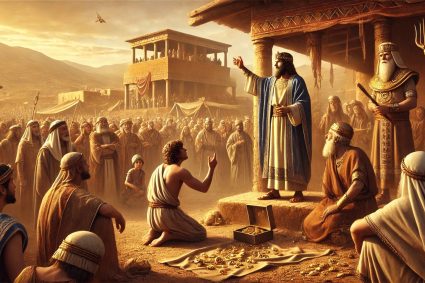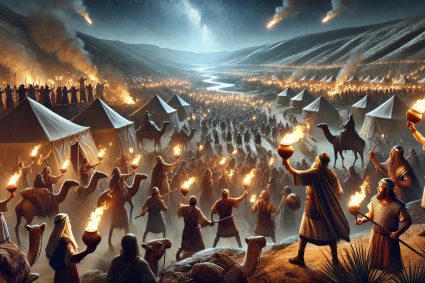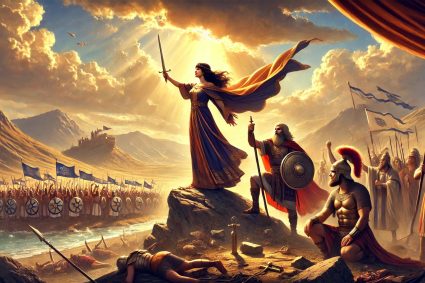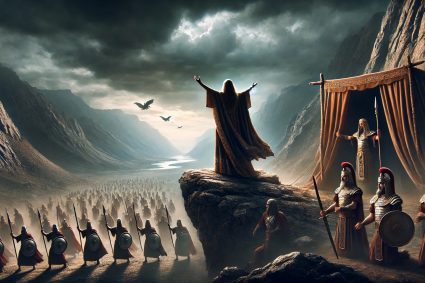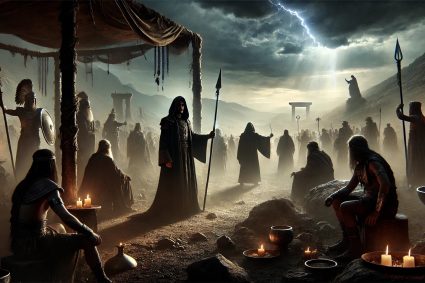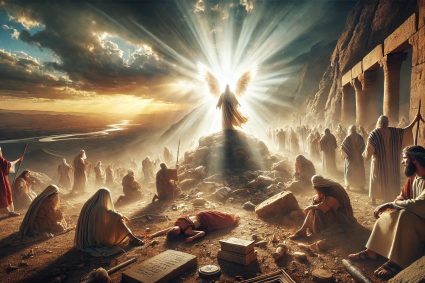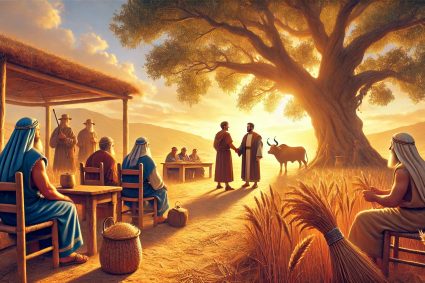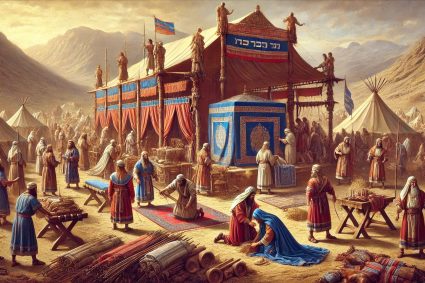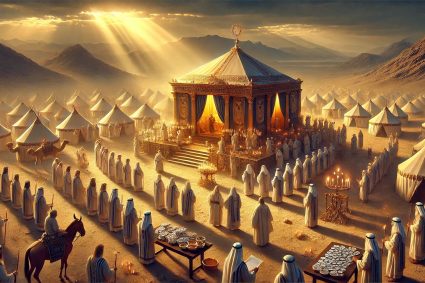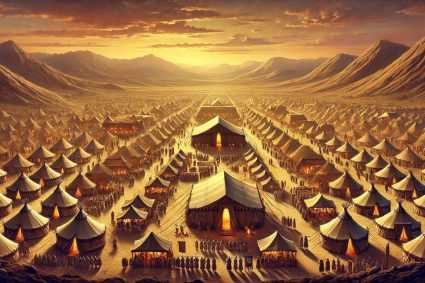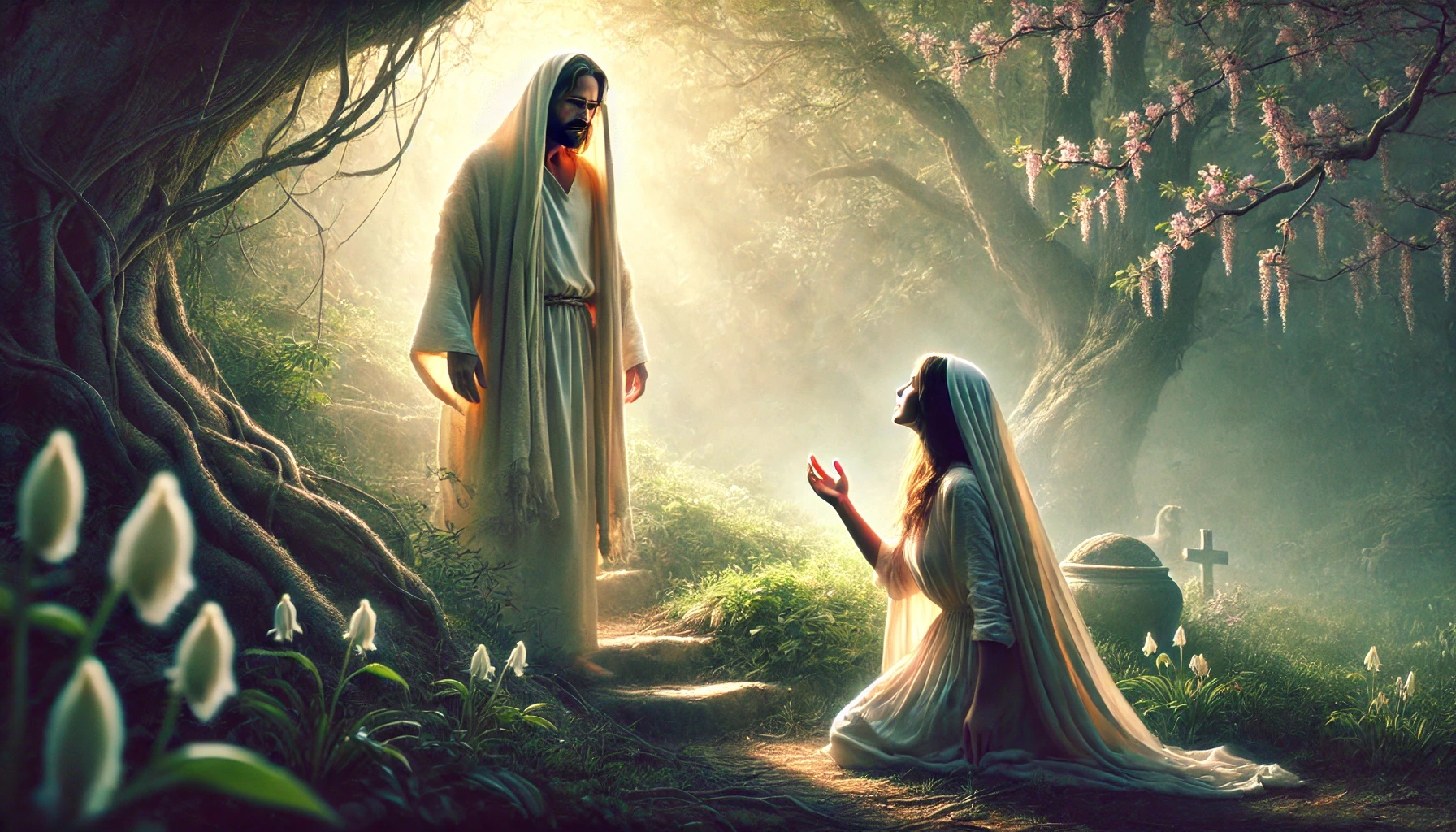
October 26, 2024
DAILY BIBLE READING – John Chapter 20
1 The first day of the week cometh Mary Magdalene early, when it was yet dark, unto the sepulchre, and seeth the stone taken away from the sepulchre.
2 Then she runneth, and cometh to Simon Peter, and to the other disciple, whom Jesus loved, and saith unto them, They have taken away the Lord out of the sepulchre, and we know not where they have laid him.
3 Peter therefore went forth, and that other disciple, and came to the sepulchre.
4 So they ran both together: and the other disciple did outrun Peter, and came first to the sepulchre.
5 And he stooping down, and looking in, saw the linen clothes lying; yet went he not in.
6 Then cometh Simon Peter following him, and went into the sepulchre, and seeth the linen clothes lie,
7 And the napkin, that was about his head, not lying with the linen clothes, but wrapped together in a place by itself.
8 Then went in also that other disciple, which came first to the sepulchre, and he saw, and believed.
9 For as yet they knew not the scripture, that he must rise again from the dead.
10 Then the disciples went away again unto their own home.
11 But Mary stood without at the sepulchre weeping: and as she wept, she stooped down, and looked into the sepulchre,
12 And seeth two angels in white sitting, the one at the head, and the other at the feet, where the body of Jesus had lain.
13 And they say unto her, Woman, why weepest thou? She saith unto them, Because they have taken away my Lord, and I know not where they have laid him.
14 And when she had thus said, she turned herself back, and saw Jesus standing, and knew not that it was Jesus.
15 Jesus saith unto her, Woman, why weepest thou? whom seekest thou? She, supposing him to be the gardener, saith unto him, Sir, if thou have borne him hence, tell me where thou hast laid him, and I will take him away.
16 Jesus saith unto her, Mary. She turned herself, and saith unto him, Rabboni; which is to say, Master.
17 Jesus saith unto her, Touch me not; for I am not yet ascended to my Father: but go to my brethren, and say unto them, I ascend unto my Father, and your Father; and to my God, and your God.
18 Mary Magdalene came and told the disciples that she had seen the Lord, and that he had spoken these things unto her.
19 Then the same day at evening, being the first day of the week, when the doors were shut where the disciples were assembled for fear of the Jews, came Jesus and stood in the midst, and saith unto them, Peace be unto you.
20 And when he had so said, he shewed unto them his hands and his side. Then were the disciples glad, when they saw the Lord.
21 Then said Jesus to them again, Peace be unto you: as my Father hath sent me, even so send I you.
22 And when he had said this, he breathed on them, and saith unto them, Receive ye the Holy Ghost:
23 Whose soever sins ye remit, they are remitted unto them; and whose soever sins ye retain, they are retained.
24 But Thomas, one of the twelve, called Didymus, was not with them when Jesus came.
25 The other disciples therefore said unto him, We have seen the Lord. But he said unto them, Except I shall see in his hands the print of the nails, and put my finger into the print of the nails, and thrust my hand into his side, I will not believe.
26 And after eight days again his disciples were within, and Thomas with them: then came Jesus, the doors being shut, and stood in the midst, and said, Peace be unto you.
27 Then saith he to Thomas, Reach hither thy finger, and behold my hands; and reach hither thy hand, and thrust it into my side: and be not faithless, but believing.
28 And Thomas answered and said unto him, My Lord and my God.
29 Jesus saith unto him, Thomas, because thou hast seen me, thou hast believed: blessed are they that have not seen, and yet have believed.
30 And many other signs truly did Jesus in the presence of his disciples, which are not written in this book:
31 But these are written, that ye might believe that Jesus is the Christ, the Son of God; and that believing ye might have life through his name.
King James Version. Public Domain
Commentary
Introduction:
John Chapter 20 depicts the central and decisive message of Christian faith: the resurrection of Jesus from the dead. It describes the events of Easter morning, beginning with Mary Magdalene discovering the empty tomb, through Jesus appearing to His disciples, and culminating in the encounter with the doubting Thomas. In this chapter, not only is Jesus’ victory over death proclaimed, but also the confirmation of His divine mission and the commencement of His disciples’ mission, empowered by the Holy Spirit.
Commentary:
The chapter begins with a profound human experience: Mary Magdalene arrives early in the morning at Jesus’ tomb to cope with her grief. Her encounter with the empty tomb initially causes confusion and alarm. She believes that someone has stolen Jesus’ body and hurries to Peter and John to deliver this news. This reaction demonstrates that even Jesus’ closest friends and disciples were unprepared for the resurrection, despite Jesus having repeatedly hinted at it.
The scene where Peter and John rush to the tomb is significant. John, being faster than Peter, pauses and waits until Peter is the first to enter the tomb. This moment underscores the dynamic relationship between the two disciples: Peter, the impulsive leader, takes the initiative, while John, the beloved disciple, respectfully follows. As both enter the tomb and see the meticulously arranged linen cloths and the napkin, their faith in the resurrection begins to grow, even though they have not yet fully understood the Scriptures.
A central element of this chapter is Mary Magdalene’s encounter with the risen Jesus. Her tears and despair when she initially does not recognize Jesus reflect the human experience of grief. However, when she hears Jesus calling her by name, she recognizes Him and refers to Him as “Rabbuni”—which means “Teacher.” This intimate and personal encounter demonstrates how Jesus knows His disciples not only as teachers but also as friends and shepherds. His instruction to Mary not to touch Him indicates that He is still in the process of ascending to the Father, but also signifies that the relationship between Jesus and His disciples has now changed. He is no longer the earthly Rabbi but the glorified Son of God who will soon ascend to the Father.
Another important section of this chapter is Jesus’ first appearance to His assembled disciples on the evening of Easter day. The disciples are gathered in a locked room out of fear of the Jews, yet Jesus suddenly stands among them. His first words are, “Peace be with you,” which carry a dual meaning: on one hand, He calms their fears, and on the other, He announces the new peace His resurrection brings—the peace between God and humanity. The gesture of showing His wounds serves as confirmation that the risen Jesus is indeed the one who suffered on the cross and that His resurrection is real and physical. The breath He imparts to them is the Holy Spirit, which empowers them for their future mission and grants them the authority to forgive or retain sins.
The section involving Thomas, often called “the Doubter,” is particularly significant. Thomas was not present when Jesus first appeared to the disciples and openly expresses his skepticism. His demand to touch Jesus’ wounds to believe reflects the natural human tendency to seek evidence. Eight days later, Jesus fulfills this demand by appearing again, specifically to meet Thomas. Jesus invites him to touch His wounds, and Thomas responds, “My Lord and my God!” without hesitation, demonstrating his newfound faith. This scene not only highlights Jesus’ patient care regarding His disciples’ doubts but also emphasizes the importance of faith. Jesus’ words to Thomas—”Blessed are those who have not seen and yet have believed”—encourage all believers who have not physically seen Jesus to trust in His resurrection. This is a core tenet of the Christian faith: belief in the unseen, trust in the testimony of the Scriptures, and the testimony of the disciples.
The final two verses of the chapter (John 20:30-31) offer an important reflection on the purpose of the Gospel. John states that Jesus performed many more signs that are not recorded in this book, but what is written serves a clear purpose: to foster belief in Jesus Christ, the Son of God, so that people may have eternal life through this faith. This emphasizes that the Gospel is not merely a historical account but a means of promoting faith and redemption.
Summary:
John 20 describes Easter morning and the disciples’ encounters with the risen Jesus. Mary Magdalene discovers the empty tomb and later meets Jesus, who commissions her to convey the message of His resurrection to the disciples. Jesus appears to the disciples in the evening and imparts the Holy Spirit to prepare them for their future mission. Thomas, who initially doubted, is invited by Jesus to touch His wounds and confesses his faith. The belief in Jesus’ resurrection is emphasized as a central point of Christian faith, and John concludes the chapter by explaining that his Gospel was written to ensure that people believe in Jesus Christ and attain eternal life through this belief.
![]()

WEEKLY SPIRIT OF PROPHECY READING – Ellen White | The Desire of Ages
Chapter 72—“In Remembrance of Me”
This chapter is based on Matthew 26:20-29; Mark 14:17-25; Luke 22:14-23; John 13:18-30.
Read online here
Commentary
Introduction
Chapter 72 deals with one of the most central moments in the life of Jesus and Christian theology: the institution of the Lord’s Supper, which Jesus celebrated with His disciples during the Passover festival. This moment, described in the Gospels of Matthew, Mark, Luke, and John, marks the transition from the Jewish tradition of Passover to a new covenant, symbolized by the bread and wine that Jesus referred to as His body and blood. This act points both to His impending sacrifice on the cross and to the hope of Christ’s return. This chapter describes the profound significance of the Lord’s Supper, the despair of the disciples in the face of the impending betrayal, and the symbolic power of the promise of redemption.
Commentary
In this chapter, Jesus institutes the Lord’s Supper, making it a central rite for His followers. During the Last Passover meal, which traditionally commemorates the liberation of Israel from Egyptian bondage, Jesus gives the meal a new meaning. He takes the bread and the wine and declares that these elements represent His body and His blood, which are given for the sins of the world. Thus, the Passover, which was a symbol of the Jews’ liberation from physical slavery, is transformed into the Lord’s Supper, which signifies the liberation of humanity from the bondage of sin through Jesus’ death.
The institution of the Lord’s Supper marks the beginning of the “New Covenant,” which is sealed by Jesus’ death and resurrection. This new order replaces the old Jewish law and the ritual sacrifices. Instead, Jesus’ sacrifice and the remembrance thereof take center stage in the believers’ faith life. The chapter makes it clear that the Lord’s Supper is not merely a symbolic act but a means of spiritual strengthening that fosters community with Christ and among the believers themselves.
Judas’ behavior, as he focuses on his betrayal amidst this sacred act, highlights the stark contrast between Jesus’ gracious offer and human sin. Jesus is aware of Judas’ betrayal but continually gives him opportunities to repent, underscoring Jesus’ infinite patience and mercy. Despite the darkness surrounding Judas, the invitation to grace remains open until the last moment.
Another central point in this chapter is the emphasis on spiritual preparation and self-examination before partaking in the Lord’s Supper. Believers are called to participate at the Lord’s table in holiness and reverence. No one is to be excluded from this celebration, but it is necessary for each individual to examine their own heart before partaking in the Lord’s Supper.
Summary
Chapter 72 of the book The Life of Jesus offers a deep reflection on the institution of the Lord’s Supper by Jesus during the Passover festival. Jesus uses this opportunity to explain the bread and wine as symbols of His impending death, which will free humanity from sin. This new celebration replaces the traditional Jewish Passover and marks the beginning of the New Covenant, established through Christ’s sacrifice. The act in which Judas plans to betray Jesus demonstrates the serious consequences of sin and betrayal. At the same time, Jesus demonstrates God’s profound mercy through His patience and offer of grace. The chapter highlights the significance of the Lord’s Supper as a source of spiritual strength and community with Christ and among believers, and emphasizes the necessity of self-examination and preparation before participation. It reminds believers to live in anticipation of Jesus’ return, which is proclaimed in every celebration of the Lord’s Supper.
(Visited 19 times, 1 visits today)


